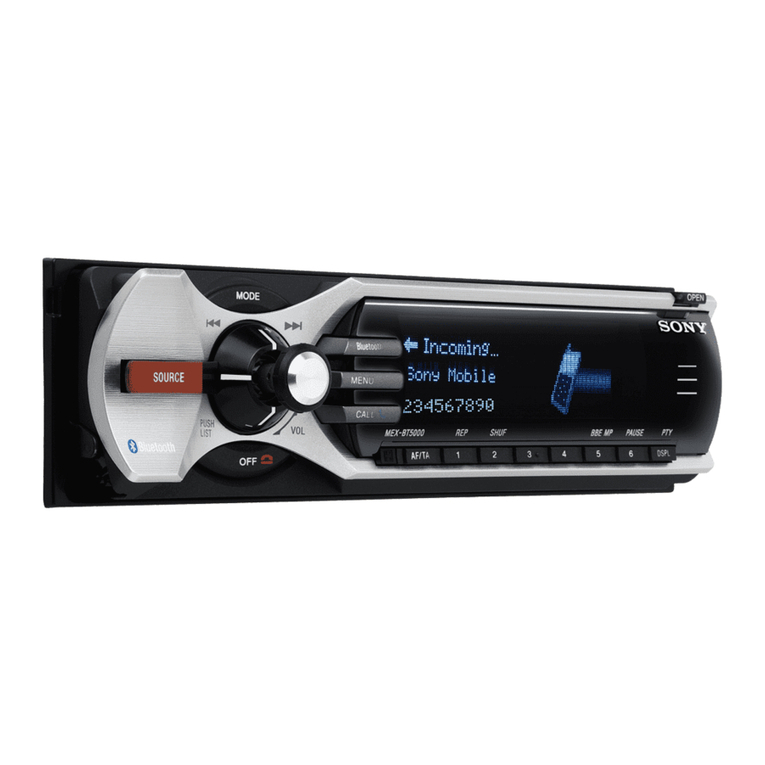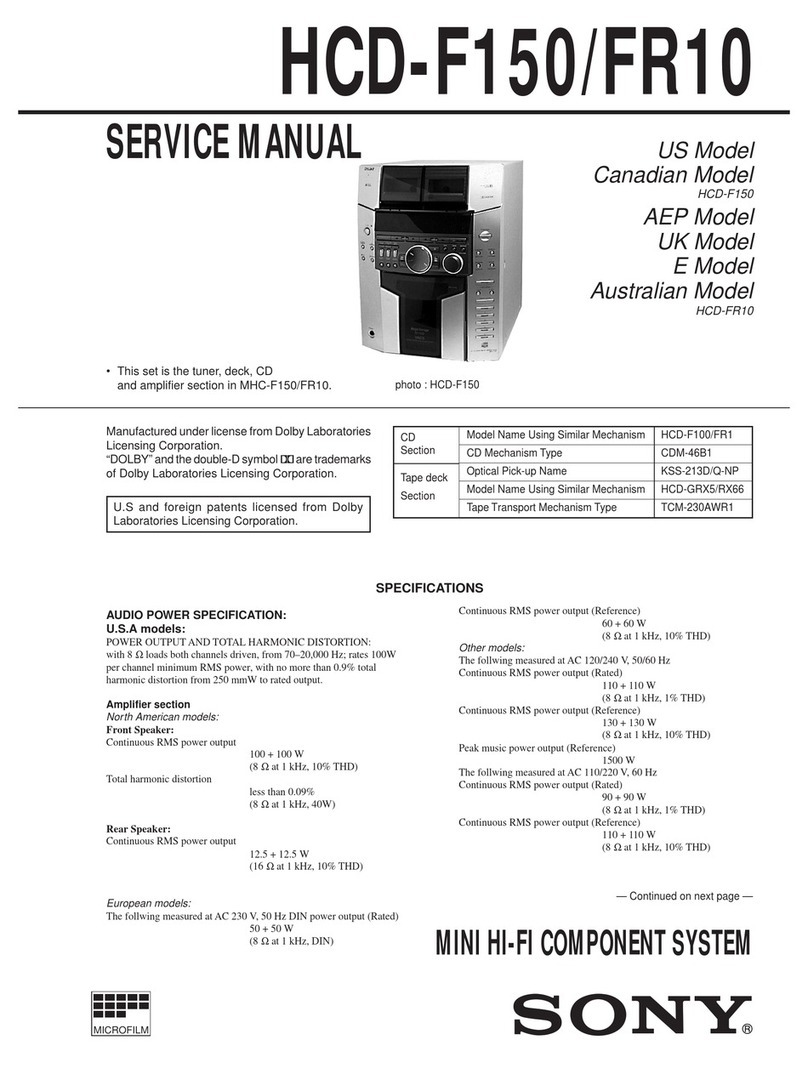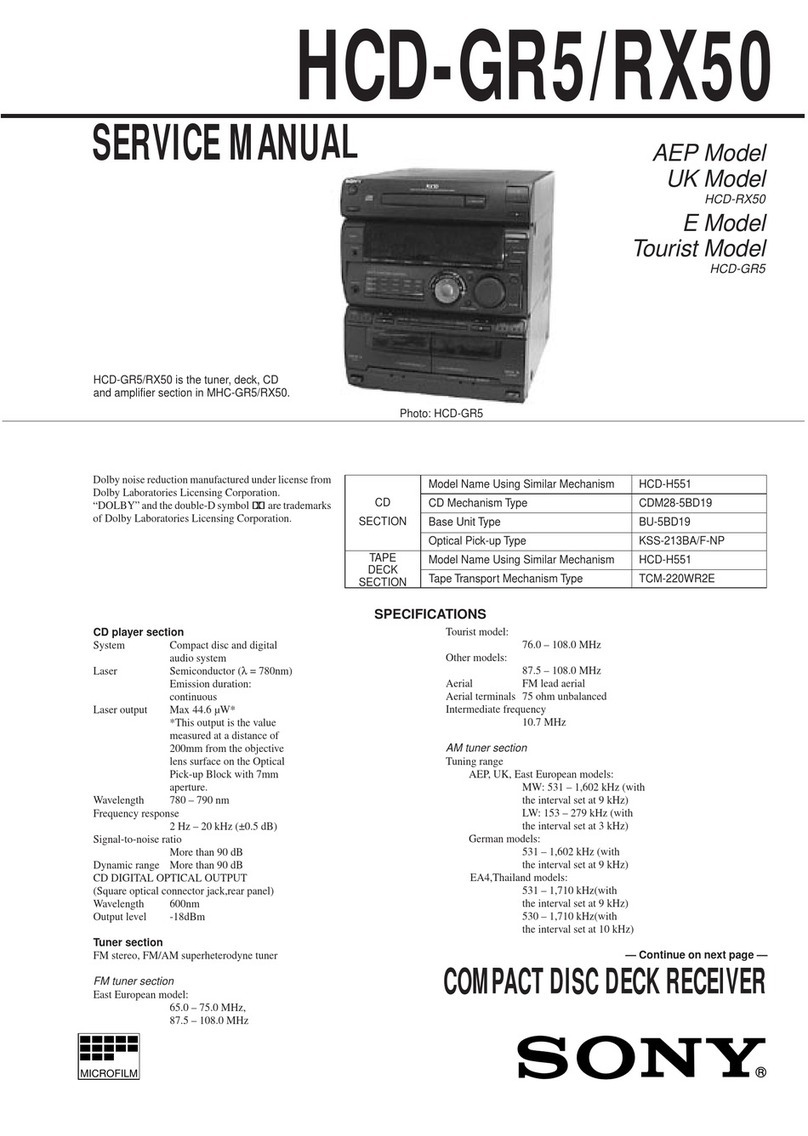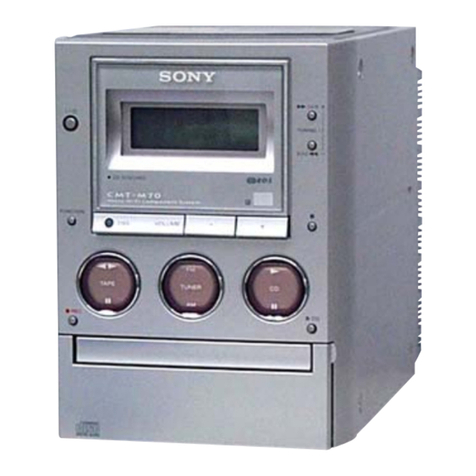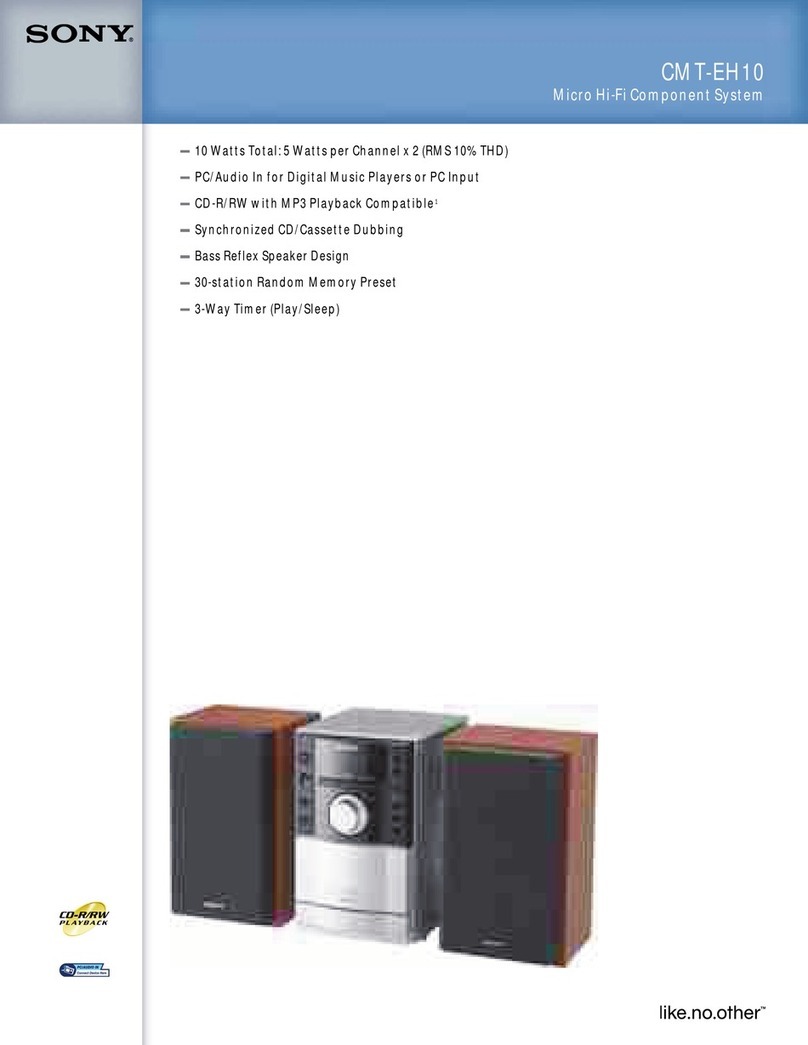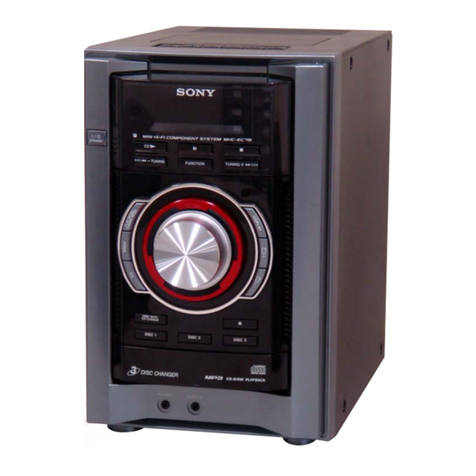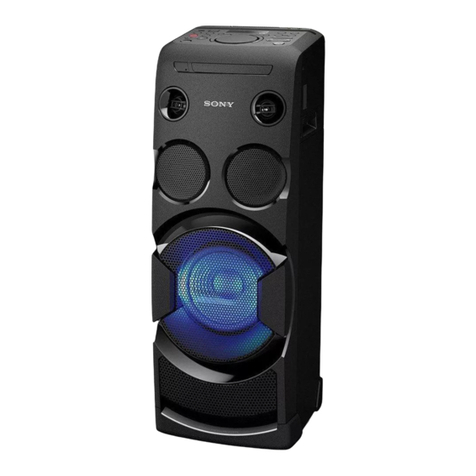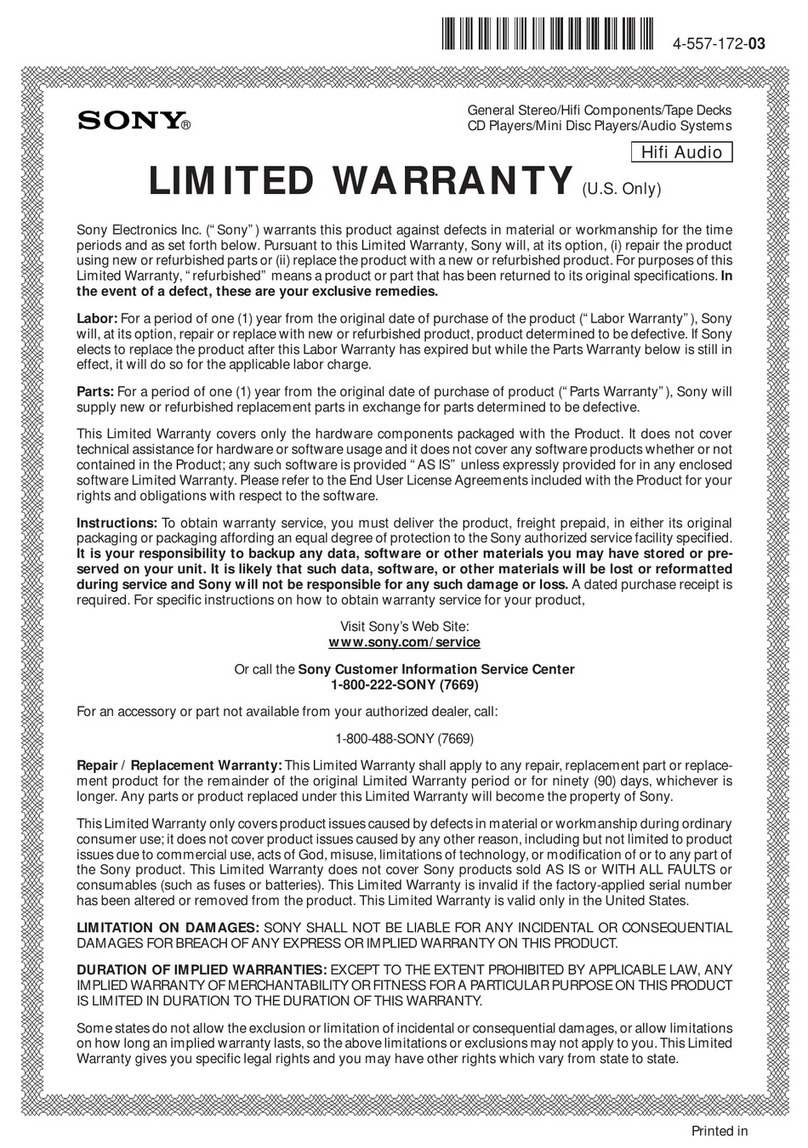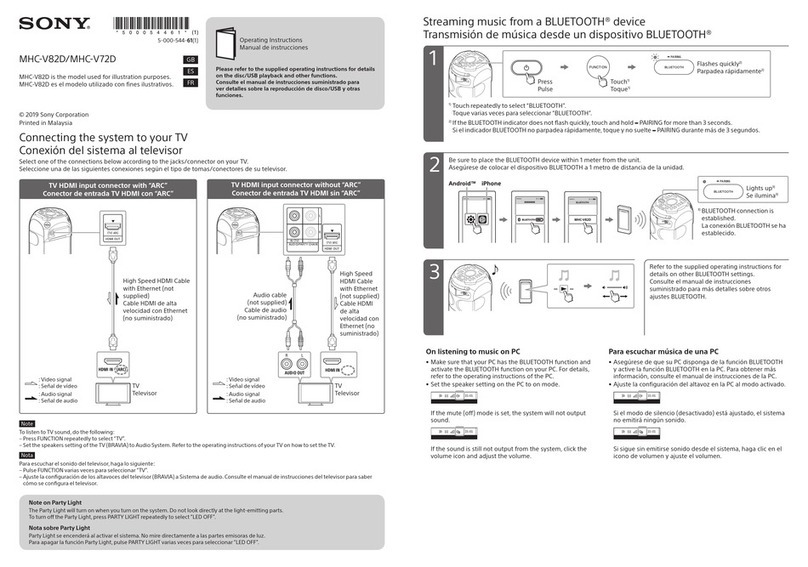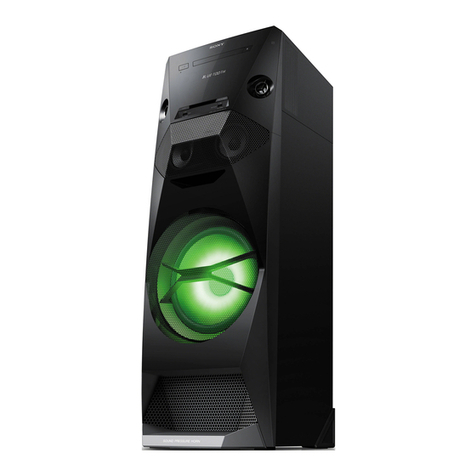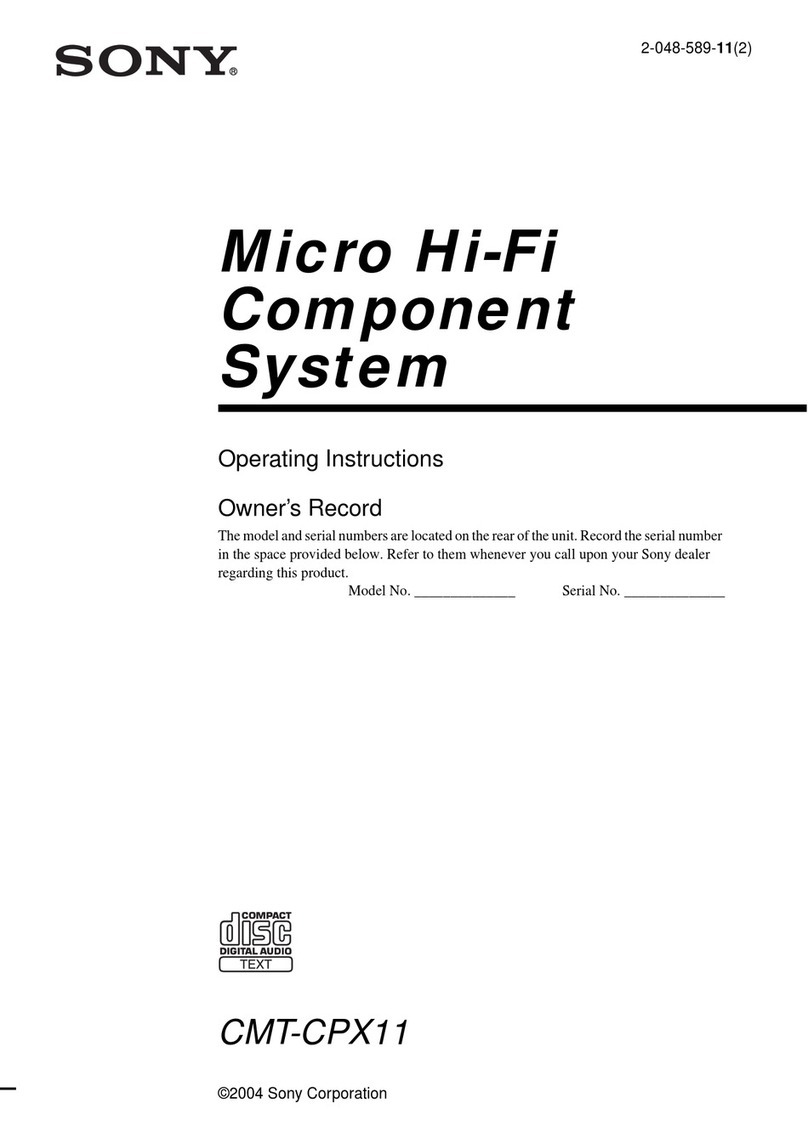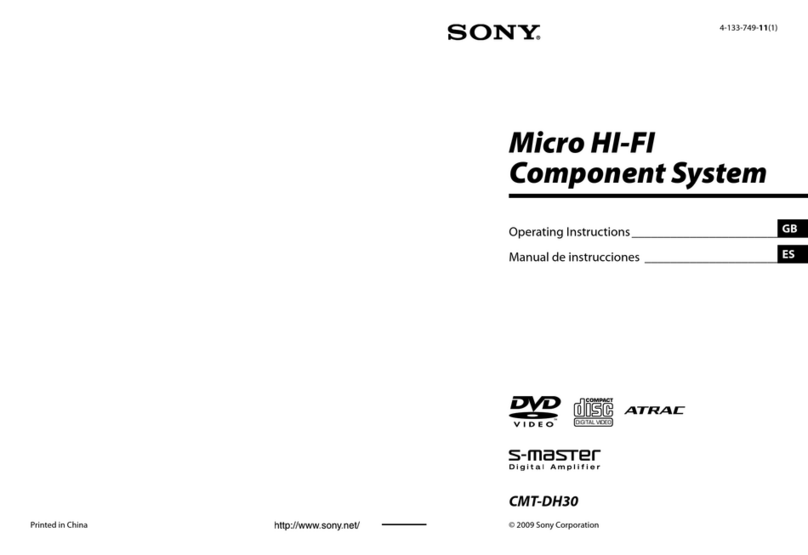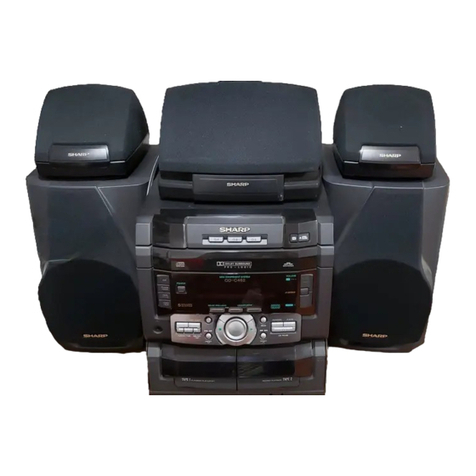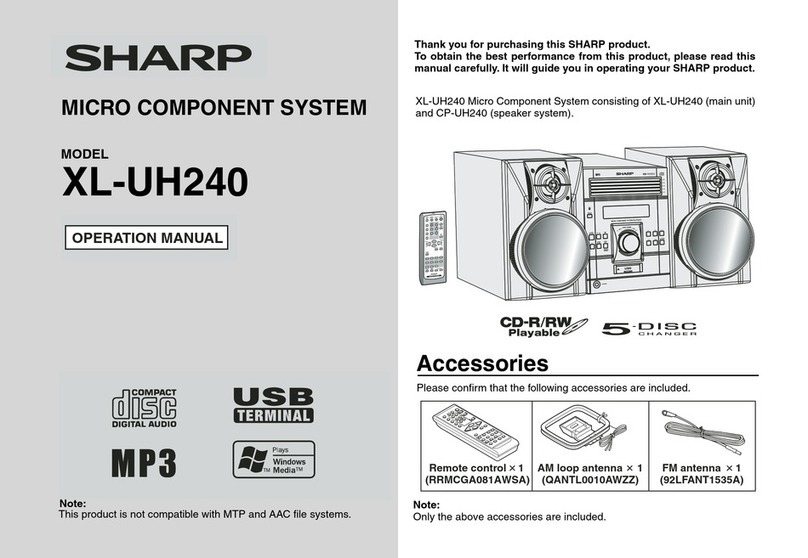HCD-EC69i/EC79i/EC99i
8
Playing the iPod
1Select the iPod function.
Press FUNCTION +/repeatedly (or iPod on
the unit).
2Place the iPod.
3Start playback.
Press (or on the unit) .
To control the iPod
You can control your iPod with the following buttons on
the remote or unit.
To Press
Pause playback (pause) (or (play/pause)
on the unit) or (stop) .
Scroll up/down the
iPod menus
/. You can scroll up or
down the iPod menus much like
the Click Wheel operations of
the iPod or the drag up-or-down
operations of the iPod touch.
Select a track
or chapter of
audiobook/podcast
(go back) /(go
forward) . To fast-forward
or fast-rewind, hold down the
button.
Choose the selected
item
/ (enter) . You can
choose the selected item much
like the center button on the iPod
or the touch operation of the
iPod touch.
Find a point in a
track or chapter of
audiobook/podcast
Hold down (rewind)
/(fast forward) during
playback, and release the button
at the desired point.
Return to the
previous menu or
select a menu
/TOOL MENU /
(return) . You can return to the
previous menu or select a menu
much like the Menu button on
the iPod or the touch operation
of the iPod touch.
To use the system as a battery charger
You can use the system as a battery charger for the iPod
when the system is on.
e charging begins when the iPod is placed on the
iPod connector. e charging status appears in the iPod
display. For details, see the user’s guide of your iPod.
To stop charging the iPod
Remove the iPod.
Notes
When placing or removing the iPod, handle the iPod in the same
angle as that of the iPod connector on the unit and do not twist or
sway the iPod to prevent connector damage.
Do not carry the unit with an iPod set on the connector. Doing so
may cause a malfunction.
When placing or removing the iPod, brace the unit with one hand
and take care not to press the controls of the iPod by mistake.
Before disconnecting the iPod, pause playback.
While playing video, you cannot use /. You can fast
rewind (fast forward) by holding down /.
To change the volume level, use VOLUME +/(or VOLUME
control on the unit) . e volume level does not change even if
adjusted on the iPod.
is system is designed for iPod only. You cannot connect any other
portable audio players.
To use an iPod, refer to the user’s guide of your iPod.
Sony cannot accept responsibility in the event that data recorded to
iPod is lost or damaged when using an iPod with this unit.
Creating your own program
(Program Play)
Use buttons on the remote to create your own program.
1Select the CD function.
Press FUNCTION +/repeatedly.
2Select the play mode.
Press PLAY MODE repeatedly until “PGM”
appears while the player is stopped.
3Select the desired track or le number.
Press /repeatedly until the desired
track or le number appears.
When programming MP3 les, press + /
repeatedly to select the desired folder, and then select
the desired le.
Selected track or le number
Total playing time of the
selected track or le
4Program the selected track or le.
Press to enter the selected track or le.
5Repeat steps 3 through 4 to program additional
tracks or les, up to a total of 25 tracks or les.
6To play your program of tracks or les, press .
e program remains available until you open the disc
tray or CD compartment (HCD-EC69i only). To play
the same program again, select the CD function, and
then press .
To cancel Program Play
Press PLAY MODE repeatedly until “PGM”
disappears while the player is stopped.
To delete the last track or le of the program
Press CLEAR while the player is stopped.
To view program information, such as total
track number of the program
Press DISPLAY repeatedly.
Using optional audio components
(except for HCD-EC69i)
1Prepare the sound source.
Connect additional audio component to the PC IN
jack on the unit using an audio analog cord (not
supplied).
2Turn down the volume.
Press VOLUME (or turn the VOLUME control on
the unit) .
3Select the PC function.
Press FUNCTION +/(or FUNCTION on the unit)
repeatedly.
4Start playback.
Start playback of the connected component.
5Adjust the volume.
Press VOLUME +/(or turn the VOLUME control
on the unit) .
Adjusting the sound
To Pres s
Generate a more dynamic
sound (Dynamic Sound
Generator X-tra)
DSGX on the unit.
Set the sound eect EQ .
To turn on the subwoofer (HCD-EC99i only)
Press SUBWOOFER ON/OFF on the unit until
“SUBWOOFER” appears. e volume of the subwoofer is
linked to the front speakers.
Changing the display
To Pres s
Change
information on the
display*
DISPLAY repeatedly when the
system is turned on.
Change Display
mode (See below.)
DISPLAY repeatedly when the
system is turned o.
* For example, you can view CD/MP3 disc information, such as;
track or le number during normal play.
track or le name (“ ”) during normal play.
artist name (“ ”) during normal play.
album or folder name (“ ”) during normal play.
total playing time while the player is stopped.
e system oers the following display modes.
Display mode When the system is o,
Power Saving
Mode1)
e display is turned o to conserve
power. e timer and clock continue
to operate.
Clock2) e clock is displayed.
1) You cannot set the clock in Power Saving Mode.
2) e clock display automatically turns to Power Saving Mode aer
8 seconds.
Notes on the display information
Characters that cannot be displayed appear as “_”.
e following are not displayed;
total playing time for an MP3 disc.
remaining playing time for an MP3 le.
e following are not displayed correctly;
elapsed playing time of an MP3 le encoded using VBR (variable
bit rate).
folder and le names that do not follow either the ISO9660
Level 1, Level 2 or Joliet in the expansion format.
e following are displayed;
total playing time for a CD-DA disc during normal play.
remaining playing time for a track.
ID3 tag information for MP3 les when ID3 version 1 and
version 2 tags are used (ID3 version 2 tag information display has
priority when both ID3 version 1 and version 2 tags are used for a
single MP3 le).
up to 15 characters of ID3 tag information using uppercase letters
(A to Z), numbers (0 to 9), and symbols (˝ $ % ’ ( ) * , – . / < = > @
[ \ ] _ ` { | } ! ? ^).
Using the timers
e system oers two timer functions. If you use both
timers, the Sleep Timer has priority.
Use buttons on the remote to use the timer functions.
Sleep Timer:
You can fall asleep to music. is function works even if
the clock is not set.
Press SLEEP repeatedly. If you select “AUTO,” the
system automatically turns o aer the current disc stops
or in 100 minutes.
Play Timer:
You can wake up to CD, tuner or iPod at a preset time.
Make sure you have set the clock.
1Prepare the sound source.
Prepare the sound source, and then press VOLUME
+/to adjust the volume.
To start from a specic CD track or audio le, create
your own program.
2Select the timer set mode.
Press TIMER MENU .
3Set the play timer.
Press /repeatedly to select “PLAY SET,” and
then press .
“ON TIME” appears, and the hour indication ashes.
4Set the time to start playback.
Press /repeatedly to set the hour, and then
press . e minute indication ashes. Use the
procedure above to set the minutes.
“OFF TIME” appears and the hour indication ashes
in the display.
5Use the same procedure as in step 4 to set the time
to stop playback.
6Select the sound source.
Press /repeatedly until the desired sound
source appears, and then press . e display
shows the timer settings.
7Turn o the system.
Press .
e system turns on 15 seconds before the preset time.
If the system is on at the preset time, the Play Timer
will not play.
Do not operate the system from the time the system
turns on until the play starts.
To check the setting
1Press TIMER MENU .
“SELECT” ashes in the display.
2Press .
3Press /repeatedly to select “PLAY SEL,” and
then press .
To cancel the timer
Repeat the same procedure as above until “OFF” appears
in step 3, and then press .
To change the setting
Start over from step 1.
Notes for the iPod user
Make sure the iPod is not playing when using the Play Timer.
e Play Timer may not be activated depending on the status of the
connected iPod.
Tip
e Play Timer setting remains as long as the setting is not cancelled
manually.




